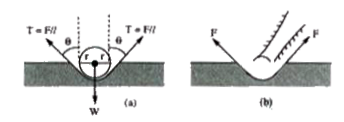The base of an insects leg is approximately spherical in shape, with a radius of about 2.0×10−5m. The 0.003g mass of the insect is supported equally by the six legs. The angle θ for an insect on the surface of water is cos−1(0.06×n). Find n.(surface tension T = 0.072 N/m)
 Solution in Telugu
Solution in Telugu
The correct Answer is:9
Step by step video, text & image solution for The base of an insects leg is approximately spherical in shape, with a radius of about 2.0 xx 10^(-5) m. The 0.003g mass of the insect is supported equally by the six legs. The angle theta for an insect on the surface of water is cos^(-1) "" (0.06 xx n). Find n.(surface tension T = 0.072 N/m) by Physics experts to help you in doubts & scoring excellent marks in Class 11 exams.
Topper's Solved these Questions
- BOOK - AAKASH SERIESCHAPTER - SURFACE TENSIONEXERCISE - ADDITIONAL PRACTICE EXERCISE (PRACTICE SHEET (ADVANCED) STRAIGHT OBJECTIVE TYPE QUESTIONS)4videos
SURFACE TENSION
- BOOK - AAKASH SERIESCHAPTER - SURFACE TENSIONEXERCISE - ADDITIONAL PRACTICE EXERCISE (PRACTICE SHEET (ADVANCED) MATRIX MATCHING TYPE QUESTIONS)1videos
SURFACE TENSION
- BOOK - AAKASH SERIESCHAPTER - SURFACE TENSIONEXERCISE - ADDITIONAL PRACTICE EXERCISE ( LEVEL-II LECTURE SHEET (ADVANCED) MATRIX MATCHING TYPE QUESTIONS)1videos
SURFACE TENSION
- BOOK - AAKASH SERIESCHAPTER - SIMPLE HARMONIC MOTION EXERCISE - ADDITIONAL PRACTICE EXERCISE (LEVEL - II)(PRACTICE SHEET (ADVANCED)) (INTEGER TYPE QUESTIONS)3videos
SIMPLE HARMONIC MOTION
- BOOK - AAKASH SERIESCHAPTER - SYSTEM OF PARTICLES AND ROTATIONAL MOTIONEXERCISE - PRACTICE EXERCISE99videos
SYSTEM OF PARTICLES AND ROTATIONAL MOTION
Similar Questions
The contact angle between a solid and a liquid is a property of
02:27View SolutionP = excess pressure value of different curvatures, r – radius, d - diameter, T - surface Tension
 01:58View Solution
01:58View SolutionMatch the following
 03:32View Solution
03:32View SolutionConsider the motion of a ball in a tunnel through the earth (radius of the earth is R and mass of the earth is M), the tunnel is along a chord and the ball is released from the surface. The time period of the ball is √x (approx), find x.
01:46View SolutionThe centre of mass of two particles with masses 2kg and 6 kg located at (1,1,1), (2,2,1) respectively has the coordinates
02:20View SolutionA spherical drop of water has 1mm radius. If the surface tension of the water is 50×10−3N/m then find the difference of pressure between inside and outside the spherical drop is :
02:43View SolutionWhen a capillary is dipped in water, water rises 0.015 m in it. If the surface tension of water is 75×10−3N/m , the radius of capillary is
03:04View SolutionSurface tension of water is 0.07 N/m . The weight of water supported by the surface tension in a capillary tube of radius 1 xx 10^(-4) m will be
03:27View SolutionIf the surface tension of water is 7.3 xx 10^(-2) N/m then the excess pressure inside a spherical drop of water of radius 1 xx 10^(-3) m formed will be
View SolutionAn air bubble of radius 0.1 mm is ready to leave the surface of a lake. Then the pressure inside in N//m^(2) is (Surface tension of water : 70 xx 10^(-3) N/m, 1 atm = 1 xx 10^(5) N//m^(2) )
02:00View SolutionThe surface tension of water is 0.07 N/m . Find the weight of water supported by surface tension in a capillary tube with a radius of 0.1 mm.
03:06View SolutionFind the pressure inside an air bubble of radius 1 mm at a depth of 20 m in water. (Assume P0 105N/m2, surface tension of water 0.072N/m )
01:33View SolutionMost of the adult insects have six legs and :-
01:37View SolutionAn air bubble of radius 2 mm is at a depth of 5 cm below the free surface of a liquid of surface tension 0.06 N/m and density 1000 kg/m ""^(3) . The pressure inside the bubble is greater than the atmospheric pressure by n xx 140 "N/m"^(2) . Find the value of n.
01:43View SolutionA capillary tube of radius r can support a liquid of weight 6.28 xx 10^(-4) N. If the surface tension of the liquid is 5 xx 10^(-2) N/m. The radius of the capillary must be:
02:03View Solution

